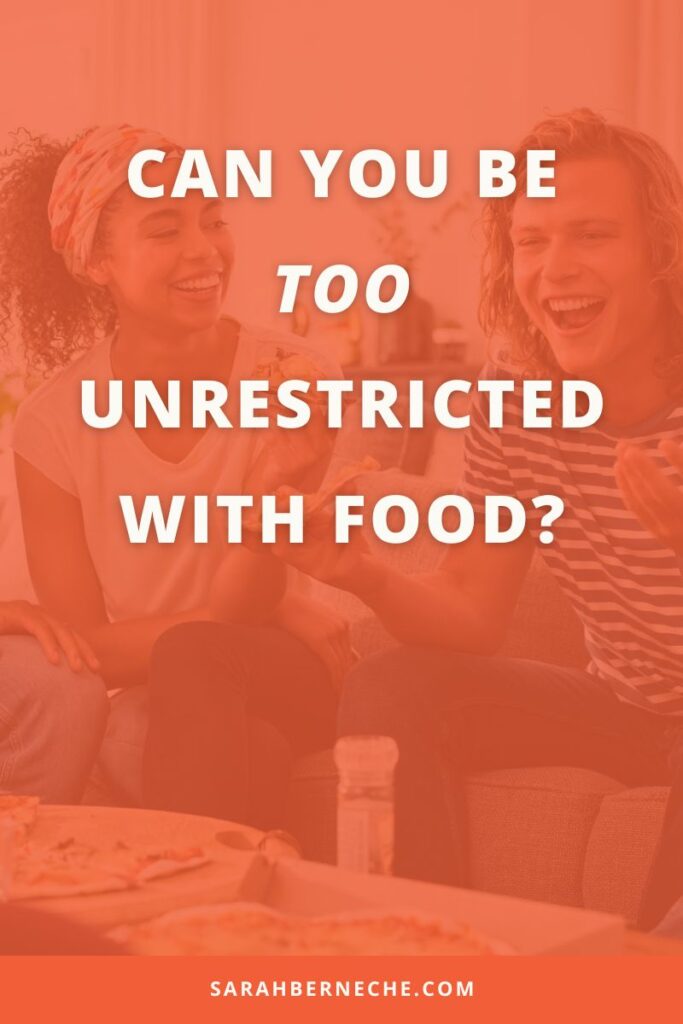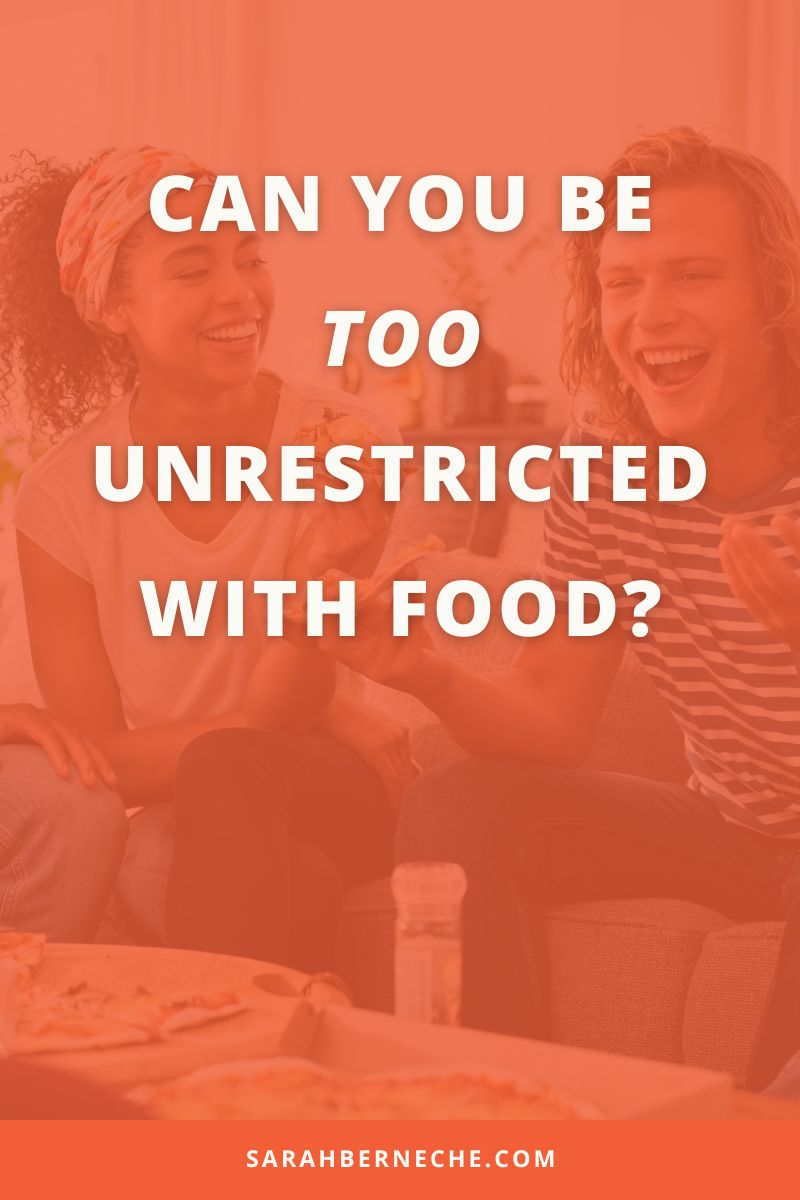Reading Time: 9 Minutes
One of the top questions you might have about Intuitive Eating is: “Can you be too unrestricted with food?”
The goal of Intuitive Eating is to connect to the wisdom of your own body to know what, when, and how much to eat, instead of using food rules or diets. When you hear this, maybe you worry you’ll never stop eating macaroni and cheese or live on take-out. These are common fears I address at length in my book on Intuitive Eating.
It doesn’t help that social media is littered with donuts and pizza. These snapshots of Intuitive Eating suggest it is little more than a food free-for-all. In truth, the framework is a dynamic interplay of reason, emotion, and instinct. While instinct does matter, reason also has an important role to fulfill.
Like instinct, donuts and pizza may certainly play a part in Intuitive Eating. But the pervasive belief that non-dieters will live on fried food and candy tells us more about how narrowly our culture defines pleasure than it does about the day in the life of an Intuitive Eater.
Satisfaction forms the “hub of the wheel” in Intuitive Eating. In the same way that living on kale would not be very satisfying, neither would subsisting for weeks on macaroni and cheese. It might just take longer to get there. This makes sense. Macaroni and cheese is rich in macronutrients and kale is not (at least without giving you a tummy ache. IYKYK.)
Now that I’ve established Intuitive Eating can encompass both physical and emotional well-being, can you be “too loose” with the guidelines? Can you be too unrestricted with food? Don’t you need to control food in some way? Take a seat, bring your favourite beverage, and let’s chat.

Responding Versus Reacting
Unlike dieting, Intuitive Eating is a practice more akin to yoga or meditation. It’s something that builds and deepens with time. It’s not something you flip on like a light switch. Part of this practice involves learning how to respond rather than react.
Diet culture has demonized so many nutritious foods over the years. Some of these include avocados (the 90s, baby), rice, potatoes, and even poor butternut squash. In light of this, eating cookies and ice cream intentionally or not defaulting to the “healthiest” option can seem downright sacrilegious.
All of this conflicting messaging does a number on your ability to tune into your intuition. It can make it challenging to respond to your basic needs without guilt, shame, or self-beratement.
Dieting, or making sometimes drastic changes to your eating and exercise behaviours, is incredibly reactionary.
Dieting happens in reaction to something — and then you stop dieting as your body reacts to the enforced food restriction.
Feeling out of control around food occurs in reaction to not getting enough food.
Emotional eating and binge eating usually occur in reaction to, broadly speaking, inadequate access to nourishment.
“Cheat days” happen in reaction to restriction. Rinse and repeat.
The goal of Intuitive Eating is to remove reaction from the equation and replace it with responsiveness.
Intuitive Eating is focused on fully responding to hunger and fullness.
Responding to cravings and honouring your appetite.
Responding to your need for rest and movement, whatever that looks like for you.
Responding to basic needs for sleep, water, and connection.
Responding to your needs for a variety of foods — including ones that fulfill physical health needs and emotional health needs.
Noticing and responding to what feels good and what doesn’t.
If you’re worried about eating in ways that are “too unrestricted,” what are you comparing it to? (And why is it always the rules of diet culture.)
Related: Should I Always Honour My Hunger?
Control Versus Structure
I’m often asked if structure has a place within Intuitive Eating or recovery. My answer (after years of contemplation) is a resounding yes.
While dieting is all about control, structure promotes a positive relationship with food.
Sometimes this structure looks loose, like with Intuitive Eating. Sometimes it’s tight, like with a structured meal plan in eating disorder recovery.
The goal of structure is always to help you eat enough food. Some other goals might be to experiment with foods you might not normally eat in a contained way, or to ensure you consume enough nutrition to meet your daily needs.
It’s common for people to eat in somewhat erratic ways when they start Intuitive Eating on their own. Dieting doesn’t necessarily promote regular and consistent eating. How many people do you know to skip breakfast as a rule or attempt to “save up” for meals out?
If you’re worried you’ll be too unrestricted with food if you stop dieting, it might be worth looking at your overall self-care.
Do you maintain regular sleep and wake cycles?
Do you eat regular and consistent meals right now?
Do you take breaks?
Do you have any regular practices or habits?
Is there enough overall structure in your life to support the looser structure of self-directed eating?
It’s not a deal-breaker if there isn’t enough structure. Multiple “attunement disrupts” as we call them just means the initial work will involve implementing self-care practices. This will set you up to successfully cultivate a connected relationship with food.
Connection Is An Inside Job
Dieting trains you to hyper-focus on what food looks like.
Intuitive Eating builds skills to help you to focus on how food feels.
Like many people, maybe you have a lot of food and nutrition knowledge in the early days of Intuitive Eating. You’re accustomed to making food choices from thought.
But you haven’t had enough time to become an embodied eater. Your values, intuition, and self-trust all come into play when learning how to eat. These are the aspects you want to build up so that you can go from judging how food is going by looking at it versus noticing how food is going by feeling for it.
If you glance over the past week and see a host of things you wouldn’t have eaten previously, it can lead you to question the process and even throw in the towel on recovery.
Remember that connection is an inside job, not an outside job.
Rather than tally up what you’ve eaten and use it as proof of how you’re doing, seize the opportunity to get curious about your internal experience (if you’re able.)
How are you feeling in your body?
If you feel out of control around food or “too” unrestricted, what else might feel out of control in your life?
Dieting is a Coping Mechanism
If both under-eating and over-eating are coping mechanisms, you’ll need some new coping strategies. In Somatic Experiencing, we call them “resources” or “glimmers.” They’re used to manage the contents of what comes up.
When you stop dieting or restrict less, it’s normal for a surge of emotions, sensations, and other experiences to surface. I don’t say that to scare you away, but to prepare you for what to expect.
Like many, perhaps you weren’t taught how to recognize, name, and allow feelings. Food — eating it or restricting it —can be the way to manage these experiences.
When you say you feel out of control, I believe you.
But in these moments I find it helpful to remind you that food can’t be out of control.
The experience is absolutely true…but it doesn’t mean it’s about food.
For this reason, I often work with clients to develop these resources/glimmers at the onset of our work. Many people struggle with Intuitive Eating and worry about being “too unrestricted” because they don’t have tools other than food (eating it or restricting it) to support them.
Related: All Eating is Emotional…So What is Emotional Eating?
Cross the Line in the Sand
Peter Levine says, “In response to threat and injury, animals, including humans, execute biologically based, non-conscious action patterns that prepare them to meet the threat and defend themselves. The very structure of trauma, including activation, dissociation, and freezing [is] based on the evolution of survival behaviours.
When threatened or injured, all animals draw from a “library” of possible responses. We orient, dodge, duck, stiffen, brace, retract, fight, flee, freeze, collapse, etc. All of these coordinated responses are somatically based — they are things that the body does to protect and defend itself. It is when these orienting and defending responses are overwhelmed that we see trauma.”
Part of trauma resolution entails helping people to complete the appropriate actions — what wanted to happen — to discharge survival energy.
Why am I bringing this up on a post about unrestricted eating?
Because the body can experience dieting as trauma.
Famine can be traumatic.
Food insecurity can be traumatic.
Being forced to eat food that you do not want can be traumatic.
Not getting enough food — which is often substantially more than what most diets recommend — can be traumatic to the body.
The diet cycle stops once you’re nutritionally rehabilitated. When you stop managing the effects of dieting with a “library” of options (e.g. appetite suppression, compensatory behaviours, etc) and nourish yourself consistently, regularly, and adequately, you can start to live in the middle ground with food.
If the dieting or restriction is severe enough and goes on long enough, you may see the impact of it on your body in the form of digestive issues, bone issues, cardiovascular issues, and more.
All of this is to say that it is common to eat more “forbidden” foods at the beginning of the process. In the “honeymoon days” of Intuitive Eating, you might find you crave fewer vegetables and more of the foods you’ve deprived yourself of. It doesn’t mean that this will go on forever, but it is something that happens for many people.
One reason is to complete the diet cycle.
Sometimes it’s to correct macronutrient and/or micronutrient deficiencies.
Sometimes it’s to stop the emotional deprivation you feel around food.
But to do that, you need to slowly, thoughtfully, and methodically move closer and closer to what scares you.
Related: What is the Diet Cycle?
Related: The Starvation Study That Changed the World
⠀

Comments +